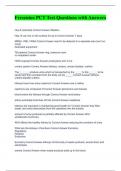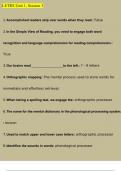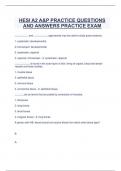Lecture 1 – Adolescent development from a neuroscience perspective
Braintime study – aim to have a better understanding of the adolescent brain
The goals:
- To explain adolescent development from a neuroscientific perspective, bridging neural and
social-emotional and cognitive development
- To use neuroscientific theories to explain adolescent behaviour
- To critically evaluate experimental designs based on knowledge gained on neuroscience
research methods.
Grey matter contains most of the brain's neuronal cell bodies.The grey matter includes regions of the
brain involved in muscle control, and sensory perception such as seeing and hearing, memory,
emotions, speech, decision-making, and self-control.
White matter is the tissue through which messages pass between different areas of grey matter within
the central nervous system. The white matter is white because of the fatty substance (myelin) that
surrounds the nerve fibers (axons). This myelin is found in almost all long nerve fibers, and acts as an
electrical insulation. This is important because it allows the messages to pass quickly from place to
place.
Within a nervous system, a neuron, neurone, or nerve cell is an electrically excitable cell that fires
electric signals called action potentials across a neural network. Neurons communicate with other cells
via synapses - specialized connections that commonly use minute amounts of
chemical neurotransmitters to pass the electric signal from the presynaptic neuron to the target cell
through the synaptic gap
MRI (Magnetic Resonation Imaging)
You can get different types of pictures with the MRI. If you want to look at the brain structure then
you’ll use MRI. If you want to look at the brain functions youll use an fMRI (functional MRI)
The MRI is a huge magnet, so metal is not allowed. There is a screen within the MRI, and most of the
time buttons or a joystick is used so that participants can still do the task. Headphones are used since
the MRI is really loud.
You can’t take a picture all at once, you do slices of pictures. You divide the brain into 30-40 slides,
and then you can get a full picture.
It’s an indirect method to see brain activity. You measure the increased blood flow (more oxygen =
more activity). Rather slow since it’s indirect.
BOLD-effect (Blood Oxygenation Level Dependent)
Changing hemoglobine in red blood cells: magnetic properties of hemoglobine is measurable.
,EEG
You wear multiple electrodes on your head which measures the electric activity of the brain (rather
than the blood oxygen level).
There is a high temporal resolution because the cap picks up the electrons rather quickly. However
there is low spatial resolution
It cannot pick up activity in the subcortical areas, this is a disadvantage. Only picks up signals on the
surface.
Since temporal resolution is quite high it is often used to examine process who are fast, such as
hearing or speaking.
EEG vs fMRI
- EEG is faster than fMRI
- EEG is a non-invasive technique
- EEG had a high temporal resolution
What should you pay attention to when you read an fMRI study?
Let’s say you want to study what happens in the brain, what happens when you view faces?
Don’t look at activity, the brain is always active. You want to isolate a certain region that is active
when viewing faces to examine contrast and mental condition that isolates important factors that relate
to viewing faces.
You want to have a good control group in an experimental design.
Control condition example of viewing houses vs. viewing faces.
Control condition example of viewing faces vs scrambled faces.
They remove noise from the data because it doesn’t look like the faces.
The visual input of the scrambled face is very similar to that of the face because of the colour
distribution.
Thus it is important to have a good control condition because it could affect your study results. This is
something to look for when reading an article.
For fMRI you need a lot of trials to pick up something and to make a reliable conclusion.
Faces vs. houses
You take an average of faces as houses and put them next to each other and you can make your
conclusions on that.
,You’re differentiating when looking at faces and houses, you relate this to the brain region who is
more active at that very
moment.
When doing an analysis of the
brain, just as told earlier you
take slices of the pictures and
put them altogether in the end.
Voxels, kind of like pixels are
used to form the brain image.
Keep in mind with fMRI:
- BOLD is not an absolute measure of brain activation but relative
- Control condition is thus crucial
- Many trials are necessary per condition (>20)
- Fixation between trials (little dot or cross to keep focus)
- Engage participants in the research while doing fMRI, don’t let them fall asleep haha
The above was information of today’s paper
Adolescence = growing up to be an adult; between childhood and adulthood.
It starts with hormonal changes (there will be a lecture about this). But when is it finished? So when
are you an adult? When can we say someone is an adult?
- Societal norms at 18 (culturally determined)
- Brain fully developed at 25.
We didn’t know any of this brain information beforehand, only since 20 years. But before that we
already determined when someone had reached adulthood. Culture determinants is really important for
when reaching adulthood.
Often what we say is that people in their early twenties are also adolescents. Then we say people who
are 18 are young adults or late adolescents.
When you look at a childs brain and an adults brain they look really similar in size. But many
structural changes occur before birth.
, When zooming in there are structural changes taking place between childhood and adulthood.
The connections between brain cells (neuron) are increased, so the strength of connections increase.
And there is an increase in myelination of the cortex while being a baby.
Increase in white matter due to new connections between neurons (increase in myelination). We see an
U shaped form that after a while up after the reach of adulthood white matter will decrease.
With gray matter in overall it decreases along adolescence. But it is not as straightforward. Data from
the Braintime study has been used to conclude this.
There is a non-linear decrease until young adulthood. The process of gray matter is due to this:
1. Synaptogenesis: increase in synapses. More synapses are formed between neurons, so one
chemical reaction has been formed within one cell to another cell. Which explains the increase
in gray matter
2. Pruning: elimination of excess synapses. Explains the decrease in gray matter structure
*Differential trajectories across brain regions. Not all changes in decrease happens at the same time
and counts for all brain regions.
The more purple a brain is the more cortical thinning,
so less gray matter structure.
Overall there is a decrease in gray matter into
adolescence. However is that some parts of the brain
are more purple at earlier ages than other regions.
The occipital lobe is already purple because the vision
is already developed from quite a young age.
Whereas the frontal and temporal brain areas are
developed later on.
Braintime study – aim to have a better understanding of the adolescent brain
The goals:
- To explain adolescent development from a neuroscientific perspective, bridging neural and
social-emotional and cognitive development
- To use neuroscientific theories to explain adolescent behaviour
- To critically evaluate experimental designs based on knowledge gained on neuroscience
research methods.
Grey matter contains most of the brain's neuronal cell bodies.The grey matter includes regions of the
brain involved in muscle control, and sensory perception such as seeing and hearing, memory,
emotions, speech, decision-making, and self-control.
White matter is the tissue through which messages pass between different areas of grey matter within
the central nervous system. The white matter is white because of the fatty substance (myelin) that
surrounds the nerve fibers (axons). This myelin is found in almost all long nerve fibers, and acts as an
electrical insulation. This is important because it allows the messages to pass quickly from place to
place.
Within a nervous system, a neuron, neurone, or nerve cell is an electrically excitable cell that fires
electric signals called action potentials across a neural network. Neurons communicate with other cells
via synapses - specialized connections that commonly use minute amounts of
chemical neurotransmitters to pass the electric signal from the presynaptic neuron to the target cell
through the synaptic gap
MRI (Magnetic Resonation Imaging)
You can get different types of pictures with the MRI. If you want to look at the brain structure then
you’ll use MRI. If you want to look at the brain functions youll use an fMRI (functional MRI)
The MRI is a huge magnet, so metal is not allowed. There is a screen within the MRI, and most of the
time buttons or a joystick is used so that participants can still do the task. Headphones are used since
the MRI is really loud.
You can’t take a picture all at once, you do slices of pictures. You divide the brain into 30-40 slides,
and then you can get a full picture.
It’s an indirect method to see brain activity. You measure the increased blood flow (more oxygen =
more activity). Rather slow since it’s indirect.
BOLD-effect (Blood Oxygenation Level Dependent)
Changing hemoglobine in red blood cells: magnetic properties of hemoglobine is measurable.
,EEG
You wear multiple electrodes on your head which measures the electric activity of the brain (rather
than the blood oxygen level).
There is a high temporal resolution because the cap picks up the electrons rather quickly. However
there is low spatial resolution
It cannot pick up activity in the subcortical areas, this is a disadvantage. Only picks up signals on the
surface.
Since temporal resolution is quite high it is often used to examine process who are fast, such as
hearing or speaking.
EEG vs fMRI
- EEG is faster than fMRI
- EEG is a non-invasive technique
- EEG had a high temporal resolution
What should you pay attention to when you read an fMRI study?
Let’s say you want to study what happens in the brain, what happens when you view faces?
Don’t look at activity, the brain is always active. You want to isolate a certain region that is active
when viewing faces to examine contrast and mental condition that isolates important factors that relate
to viewing faces.
You want to have a good control group in an experimental design.
Control condition example of viewing houses vs. viewing faces.
Control condition example of viewing faces vs scrambled faces.
They remove noise from the data because it doesn’t look like the faces.
The visual input of the scrambled face is very similar to that of the face because of the colour
distribution.
Thus it is important to have a good control condition because it could affect your study results. This is
something to look for when reading an article.
For fMRI you need a lot of trials to pick up something and to make a reliable conclusion.
Faces vs. houses
You take an average of faces as houses and put them next to each other and you can make your
conclusions on that.
,You’re differentiating when looking at faces and houses, you relate this to the brain region who is
more active at that very
moment.
When doing an analysis of the
brain, just as told earlier you
take slices of the pictures and
put them altogether in the end.
Voxels, kind of like pixels are
used to form the brain image.
Keep in mind with fMRI:
- BOLD is not an absolute measure of brain activation but relative
- Control condition is thus crucial
- Many trials are necessary per condition (>20)
- Fixation between trials (little dot or cross to keep focus)
- Engage participants in the research while doing fMRI, don’t let them fall asleep haha
The above was information of today’s paper
Adolescence = growing up to be an adult; between childhood and adulthood.
It starts with hormonal changes (there will be a lecture about this). But when is it finished? So when
are you an adult? When can we say someone is an adult?
- Societal norms at 18 (culturally determined)
- Brain fully developed at 25.
We didn’t know any of this brain information beforehand, only since 20 years. But before that we
already determined when someone had reached adulthood. Culture determinants is really important for
when reaching adulthood.
Often what we say is that people in their early twenties are also adolescents. Then we say people who
are 18 are young adults or late adolescents.
When you look at a childs brain and an adults brain they look really similar in size. But many
structural changes occur before birth.
, When zooming in there are structural changes taking place between childhood and adulthood.
The connections between brain cells (neuron) are increased, so the strength of connections increase.
And there is an increase in myelination of the cortex while being a baby.
Increase in white matter due to new connections between neurons (increase in myelination). We see an
U shaped form that after a while up after the reach of adulthood white matter will decrease.
With gray matter in overall it decreases along adolescence. But it is not as straightforward. Data from
the Braintime study has been used to conclude this.
There is a non-linear decrease until young adulthood. The process of gray matter is due to this:
1. Synaptogenesis: increase in synapses. More synapses are formed between neurons, so one
chemical reaction has been formed within one cell to another cell. Which explains the increase
in gray matter
2. Pruning: elimination of excess synapses. Explains the decrease in gray matter structure
*Differential trajectories across brain regions. Not all changes in decrease happens at the same time
and counts for all brain regions.
The more purple a brain is the more cortical thinning,
so less gray matter structure.
Overall there is a decrease in gray matter into
adolescence. However is that some parts of the brain
are more purple at earlier ages than other regions.
The occipital lobe is already purple because the vision
is already developed from quite a young age.
Whereas the frontal and temporal brain areas are
developed later on.






